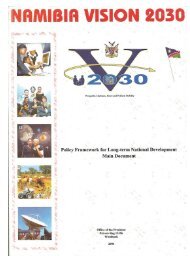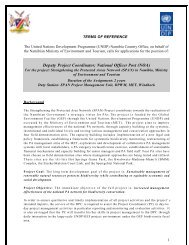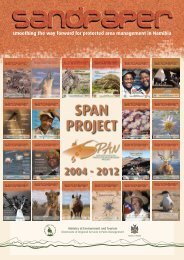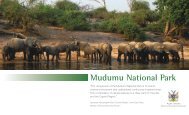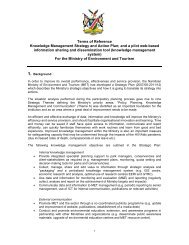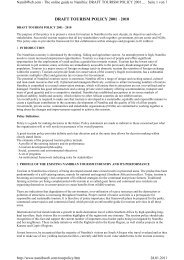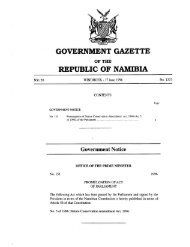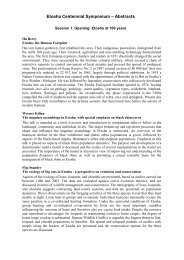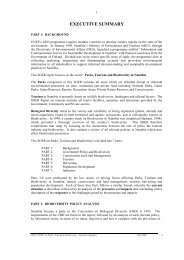HWCM - Ministry of Environment and Tourism
HWCM - Ministry of Environment and Tourism
HWCM - Ministry of Environment and Tourism
Create successful ePaper yourself
Turn your PDF publications into a flip-book with our unique Google optimized e-Paper software.
National Workshop on Human Wildlife Conflict Management 2005<br />
1. The data collection scheme is discussed <strong>and</strong> explained to the affected<br />
community;<br />
2. The enumerators are selected from the affected community;<br />
3. Enumerators trained using a st<strong>and</strong>ard training package;<br />
4. The incident is reported to the enumerator;<br />
5. Enumerator visits site <strong>and</strong> interviews affected persons;<br />
6. Enumerator makes assessment <strong>of</strong> damage using a st<strong>and</strong>ard “Elephant<br />
Damage Form”.<br />
2. Secondary data collection <strong>and</strong> analysis<br />
1. Seriousness <strong>of</strong> each crop damage incident is further quantified by the researcher, using a<br />
very simple secondary data analysis;<br />
2. Variation in the severity <strong>of</strong> elephant crop-raiding is judged by ranking affected<br />
villages/farms;<br />
3. Annual summaries.<br />
These data can then be used for local management decisions.<br />
3. Tertiary data <strong>and</strong> analysis<br />
• Involves input <strong>of</strong> additional “site characteristics” data by the researcher;<br />
• Incident data can be linked to environmental variables in the conflict area;<br />
• Spatial analysis using GIS.<br />
Enables a deeper underst<strong>and</strong>ing <strong>of</strong> the dynamics <strong>and</strong> allows more meaningful management<br />
recommendations to be made.<br />
The AfESG’s Data Collection <strong>and</strong> Analysis Protocol<br />
Advantages:<br />
• Simple to use <strong>and</strong> relatively inexpensive to set up <strong>and</strong> run;<br />
• Data entry <strong>and</strong> reporting can be done manually;<br />
• Can be easily adapted to local circumstances;<br />
• Yields good information about distribution <strong>of</strong> HEC;<br />
• Allows adequate assessment <strong>of</strong> intensity;<br />
• Involves local people, provides employment <strong>and</strong> ‘ownership’; <strong>and</strong><br />
• Does not rely on the complainants or on over-stretched national wildlife authorities.<br />
Lessons learned from the practical application <strong>of</strong> the Data Collection<br />
<strong>and</strong> Analysis Protocol<br />
General:<br />
• Has been successfully used to cover very large areas;<br />
• No data collected is ever wasted;<br />
• Can generate other useful ancillary data;<br />
• Can serve first step in devolving responsibility for management to the local level.<br />
But:<br />
53



